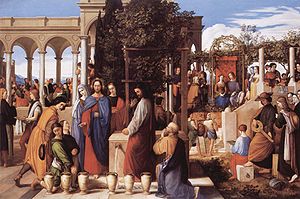
A Gospel without Parables?
We all know the standard line: the synoptic evangelists tell us that Jesus’ ministry heavily relied on parables, while the Fourth Gospel contains none. It’s a striking conundrum. However, for a long time now I’ve been considering the possibility that John is itself entirely a parable gospel.
That is to say, each pericope may stand primarily as an allegorical story, regardless of whether it is based on historical events. The story of Jesus changing the water into wine, for example, seems to contain so many obvious references — narrative points and objects that have direct theological allusions — that resemble the parables in the other gospels.
Rudolf Bultmann in The Gospel of John: A Commentary (1971, pp. 114-121) counsels us not to overstate the significance of the water as referring to baptism, blood, or the new covenant. On the other hand, F.F. Bruce writes:
Jesus’ action was, in C. S. Lewis’s terminology, a ‘miracle of the old creation’: the Creator who, year by year, turns water into wine, so to speak, by a natural process, on this occasion speeds up the process and attains the same end. But if it is a miracle of the old creation, it is a parable of the new creation. (p. 45, The Gospel of John: Introduction, Exposition, Notes, emphasis mine)
John as “Megaparable”
If Bultmann gave us a red light, Bruce at least changed that light to amber. Earlier this year in The Power of Parable, John Dominic Crossan changed it to full-on green. He subtitles chapter 10: “The Parable Gospel according to John,” writing:
John interprets all the physical or restorative miracles of Jesus as symbolic of what God is in Jesus rather than of what God does in Jesus. Look back, for example, at John 4 and note how physical drinking in 4:7-15 and physical eating in 4:31-38 become spiritual symbols of Jesus. Or, again, do you really think that Cana was just about wine? (Kindle location 3748, bolding mine)
It is one thing to see the symbolism in the pericopae of John’s gospel; it’s another to see them as parables. Crossan concludes this chapter by explaining that John, at least in part, is a sustained polemic against the synoptic vision of Christianity.
John’s megaparable is, in conclusion, both an attack parable directed against and from outside Judaism — like Luke-Acts — but also, and even more so, a challenge parable directed against but from inside Christianity — like Mark. (Kindle location 3966)
I think Crossan is right. Again and again, John takes a cue from the Synoptics (usually Mark or Luke), turns it on its head, and re-forms it into a new vision — a parable with Jesus as the central actor.
John as Polemic
This process is described to good effect in Thomas L. Brodie’s The Quest for the Origin of John’s Gospel: A Source-Oriented Approach. Brodie points out that the first miracle(s) (i.e., the exorcism at the end of Mark 1 and the water-into-wine miracle in John’s second chapter) have “curious links.” (See p. 70ff.) Certainly the oddest has to be the stern “What is there to me and to you?” said by the demon to Jesus in Mark and by Jesus to his unnamed mother in John.
Brodie writes:
What John apparently has done is taken Mark’s initial account of Jesus’ revealing the kingdom and synthesized it into the single image of Jesus’ (described as a king in John 1:49) revealing the fine wedding wine. Such an image is not alien; it corresponds to a major element in the description of the kingdom as being like a wedding feast (Matt 22:14). (p. 75)
Wedding Wine as Parable
Finally, while reading C.H. Dodd last week, I was surprised to find that he suspected the Cana story in John started out as a parable. He writes:
This leads me to hazard a further suggestion: that the traditional nucleus of this pericope may have been a parable, in which, as in other parables, the setting was a wedding feast. (p. 227, Historical Tradition in the Fourth Gospel)
In the end Dodd concedes the process by which a parable might have become historicized is all conjecture. However, it makes me think we’re on the right track.
In future posts I would like to explore these themes — how John used the synoptics and why, and whether Fourth Gospel is indeed a “megaparable” or at least a collection of parables starring Jesus.
If you enjoyed this post, please consider donating to Vridar. Thanks!

I have not read Crossan’s book (The Power of Parable), but on Amazon I noticed this on the book’s front flap:
Crossan’s view of the gospels as “(mis)interpetations” made me think of Michael Goulder’s theory that the Fourth Gospel’s beloved disciple was the result of a misinterpretation of certain Pauline passages:
I would like to see a lot more public debates with Christians who claim all kinds of religious magic and events. The evidence for a mythical Jesus is overwhelming, and we should not keep our light under a basket. Thanks, Gillespie